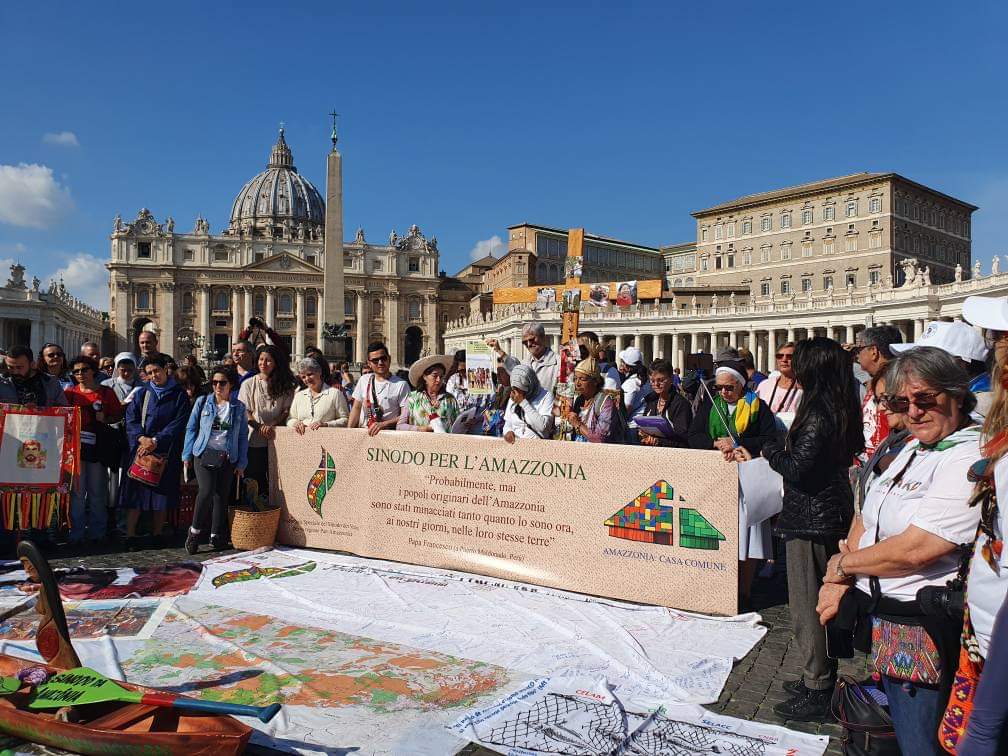Amazon Synod: One Year Later
Networks of solidarity have been built in the year following the Amazon Synod, despite many challenges.
Networks of solidarity have been built in the year following the Amazon Synod, despite many challenges. This article was published in the November-December 2020 issue of NewsNotes.
In this first year since the monumental Synod on the Amazon in Rome, the eight-country Amazon region has faced many challenges. However, the Church has forged new pathways to build solidarity with communities there as they have sought to protect themselves and one of the most biodiverse ecosystems of the world. These threats include sickness from the coronavirus, violence at the hands of individuals in extractive industries, destruction by large-scale agriculture, fires, and climate change.
Facing Multiple Threats
The coronavirus has hit the Amazon region particularly hard. As of October 22, there have been more than 1.3 million confirmed cases and 33,000 deaths from COVID-19 in the region, according to data compiled by the Pan-Amazon Ecclesial Network (REPAM) from health authorities in each of the eight countries. Officials believe that the numbers will continue to rise.
Specific to indigenous communities, there have been 66,848 confirmed cases and 2011 deaths as of October 13. The lack of resources and exposure to outsiders who carry the virus make indigenous communities more vulnerable.
“When the quarantine started, people were taking measures as much as possible; but extractive activities continued without any control,” said Susana Espinoza Soto, a member of the REPAM’s executive secretariat and coordinator of the coronavirus mapping initiative. “These activities maintained the flow of people who come and go and have greatly affected the communities.”
For example, the Yanomami, the largest relatively isolated tribe in South America, living in the rainforests and mountains of northern Brazil and southern Venezuela, blames illegal miners for a coronavirus outbreak and the murder of two indigenous leaders in their territory since April. According to one witness, the two men were murdered after requesting food from the illegal miners and having complained when they received less than was promised. There are roughly 20,000 illegal miners operating in the Yanomami territory. Brazil’s president, Jair Bolsonaro, has made statements that have emboldened illegal loggers and miners to enter the Amazon.
The Brazilian rainforest is also seeing its worst fire season in a decade, with a 61 percent rise in the number of fire hotspots between September 2019 and September 2020, due in part to drought and forest clearing for ranching and agriculture. The fires received enough international attention that U.S. presidential candidate, Joe Biden, referenced them in a debate.
Hope from the Church
The Synod’s commitment of solidarity with communities in the Amazon came before anyone knew that the pandemic would grip the world in sickness. REPAM continues to support communities through legal representation, public statements and advocacy, monitoring of the pandemic’s toll, equipping community leaders and their Church counterparts on their rights and giving them platforms to share their grievances, needs, and solutions.
The Church’s capacity to respond will only deepen with the creation of CEAMA, the Amazon Ecclesial Conference. The goal of CEAMA is to promote synodality between the churches in the region, or, as Pope Francis has said, to give the Church an “Amazonian face,” one of the pope’s four “dreams” announced in his Apostolic Exhortation, “Querida Amazonia,” in response to the Synod.
With 250 participants, CEAMA held its first virtual assembly on Oct. 26-27, one year after the Synod concluded. CEAMA has established 20 different thematic working groups, with topics ranging from increasing the role of laity, women, indigenous peoples, Mestizos, and Afro-descendants in the Church, to establishing Church-based supports for victims of the pandemic, to exploring ways to create Eucharistic communities. The assembly emphasized that the working groups should center their work on dialogue and decolonization.
The Synod also spurred the founding of networks similar to REPAM in other bioregions of the world: REMAM (Mesoamerican Ecclesial Network), RAOEN (River Above Asia Oceania Ecclesial Network), and REBAC (Ecclesial Network of the Congo Basin Forest). REBAC was established at the same time as REPAM with the recognition that the Congo and Amazon basins are the “lungs of the planet.” The networks hope to replicate the REPAM model within their own cultural and ecological contexts.
In his new encyclical, Fratelli Tutti, Pope Francis shares another dream – a dream for a world that faces global challenges as a “single human family,” brothers and sisters all. The example of dialogue and solidarity given by the Amazonian Church can help guide our efforts to pursue this global unity.

